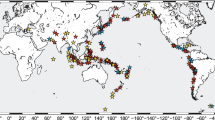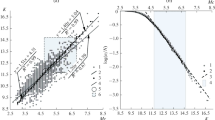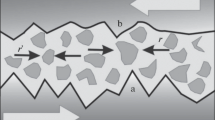Abstract
Repeat times of strong shallow mainshocks have been determined by the use of instrumental and historical data for 68 seismogenic sources in the Aegean and surrounding area (34°N–43°N, 18°E–30°E). For 49 of these sources at least two interevent times (three mainshocks) are available for each source. By using the repeat times for these 49 sources the following relation has been determined:
whereT t is the repeat time, measured in years,M p the surface wave magnitude of the preceding mainshock,M min the magnitude of the smallest earthquake considered and “a” parameter which varies from source to source. A multilinear correlation coefficient equal to 0.89 was determined for this relation.
By using the same repeat times for the 49 seismogenic sources, the following relation has been determined between the magnitude,M f , of the following mainshock andM min andM p .
wherem is a constant which varies from source to source. A multilinear correlation coefficient equal to 0.80 was found for this relation.
The model expressed by these two relations is represented by a scheme of a time variation of stress under constant tectonic loading. In this scheme, the maximum stress values during the different seismic cycles fluctuate around a value, τ1, in a relatively narrow stress interval, expressing the high correlation coefficient of the relation between LogT andM p . On the contrary, the minimum stress values fluctuate around a value, τ2, in a much broader stress interval. However, each of these minimum stress values becomes lower or higher than τ2 if the previous one is higher or lower than τ2, respectively, expressing the negative correlation betweenM f andM p .
Similar content being viewed by others
References
Anagnos, T., andKiremidjian, A. S. (1984),Stochastic Time-predictable Model for Earthquake Occurrence, Bull. Seismol. Soc. Am.74, 2593–2611.
Astiz, L., andKanamori, H. (1984),An Earthquake Doublet in Ometepec, Guerrero, Mexico, Phys. Earth. Planet. Interiors34, 24–45.
Bufe, C. G., Harsh, P. W., andBurford, R. D. (1977),Steady-state Seismic Slip: A Precise Recurrence Model, Geophys. Res. Lett.4, 91–94.
Comninakis, P. E., andPapazachos, B. C. (1986),A Catalogue of Earthquakes in Greece and Surrounding Area for the Period 1901–1985, Publ. Geophys. Lab. Univ. Thessaloniki1, 167 pp.
Cornell, C. A. (1968),Engineering Seismic Risk Analysis, Bull. Seismol. Soc. Am.58, 1503–1606.
Kirmidjian, A. S., andAnagnos, T. (1984),Stochastic Slip-predictable Model for Earthquake Occurrences, Bull. Seismol. Soc. Am.74, 739–755.
McKenzie, D. P. (1978),Active Tectonics of the Alpine-Himalayan Belt: The Aegean Sea and the Surrounding Region, Geophys. J. R. Astr. Soc.52, 217–254.
Mogi, K.,Seismicity in western Japan and long-term earthquake forecasting. InEarthquake Prediction, An International Review (eds. Simpson, D. W., and Richards, P. G.) (Maurice Ewing Series, Amer Geophys. Union 1981) Vol. 4, pp. 126–140.
Nishenko, S. P., andBuland, R. (1987),A Generic Recurrence Interval Distribution for Earthquake Forecasting, Bull. Seismol. Soc. Am.77, 1382–1399.
Papazachos, B. C. (1988a),Seismic Hazard and Long-term Earthquake Prediction in Greece, European School of Earthquake Sciences, Course on Earthquake Hazard Assessment, Athens, 9–16 May 1988, pp. 1–10.
Papazachos, B. C. (1988b),Long-term Prediction of Earthquakes in Seismogenic Sources of Greece. United Nations Seminar on the Prediction of Earthquakes, Lisbon, Portugal, 14–18 November 1988, pp. 1–10.
Papazachos, B. C. (1989),A Time-predictable Model for Earthquake Generation in Greece, Bull. Seismol. Soc. Am.79, 77–84.
Papazachos, B. C. (1990),Seismicity of the Aegean and Surrounding Area, Tectonophys,178, 287–308.
Papazachos, B. C., andPapazachou, C. B.,The Earthquakes of Greece (in Greek) (Ziti Publications, Thesssaloniki 1989) 356 pp.
Papazachos, B. C., Kiratzi, A., andPapadimitriou, E. (1991),Regional Focal Mechanism for Earthquakes in the Aegean Area, Pure and Appl. Geophys.136, 405–420.
Shimazaki, K., andNakata, T. (1980),Time-predictable Recurrence of Large Earthquakes, Geophys. Res. Lett.7, 279–282.
Sykes, L. R., andQuittmeyer, R. C.,Repeat times of great earthquakes along simple plate boundaries InEarthquake Prediction, An International Review (eds. Simpson, D. W., and Richards, P. G.) (Maurice Ewing-Series, Amer. Geophys. Union 1981) Vol. 4, pp. 297–332.
Wesnousky, S. G., Scholz, C. H., Shimazaki, K., andMatsuda, T. (1984),Integration of Geological and Seismological Data for Analysis of Seismic Hazard: A Case Study of Japan, Bull. Seismol. Soc. Am.74, 687–708.
Author information
Authors and Affiliations
Rights and permissions
About this article
Cite this article
Papazachos, B.C. A time- and magnitude-predictable model for generation of shallow earthquakes in the Aegean area. PAGEOPH 138, 287–308 (1992). https://doi.org/10.1007/BF00878900
Received:
Revised:
Accepted:
Issue Date:
DOI: https://doi.org/10.1007/BF00878900




